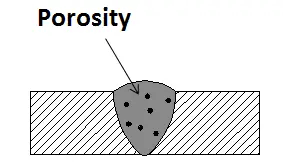Welding is a crucial process in various industries, from automotive to aerospace, where precision and strength are paramount. Tungsten Inert Gas (TIG) welding, also known as Gas Tungsten Arc Welding (GTAW), is a widely used method for achieving high-quality welds. However, one common challenge welders face is porosity in TIG welds. Porosity can compromise the integrity of welds, leading to costly rework and potential structural issues. In this guide, we'll delve into the causes of porous TIG welds and provide practical tips on how to avoid them, ensuring your welds meet the highest quality standards.

I. What Are Porous Welds?
Before we dive into prevention techniques, let's understand what porous welds are and why they are problematic. Porosity refers to the presence of small cavities or voids within the weld metal. These voids can trap gases, such as hydrogen, nitrogen, and oxygen, which can weaken the weld and compromise its integrity. Porosity can manifest in various forms, including pinholes, cracks, and irregularly shaped voids, making it essential to address this issue promptly.
II. Common Causes of Porosity in TIG Welds.
Contaminated Welding Materials: The presence of contaminants, such as oil, grease, or rust, on the base metal or filler rod, can introduce impurities into the weld, leading to porosity.
Improper Gas Shielding: In TIG welding, an inert gas (typically argon) is used to shield the weld zone from atmospheric gases. If the gas flow rate or coverage is inadequate, atmospheric gases can enter the weld, causing porosity.
Incorrect Welding Technique: Inconsistent travel speed, excessive heat input, or improper electrode angles can result in poor gas coverage and, consequently, porous welds.
Inadequate Tungsten Electrode Preparation: Tungsten electrodes must be properly prepared to maintain a stable arc and prevent contamination. Incorrect electrode grinding or sharpening techniques can lead to porosity.
Hydrogen Contamination: Moisture in the shielding gas or on the base metal can release hydrogen during welding, leading to porosity.
Dirty Work Environment: An unclean work environment can introduce contaminants that find their way into the weld, causing porosity.
Now that we've identified the primary causes of porous TIG welds, let's explore practical steps to avoid this issue and achieve flawless welds.
III. Tips to Avoid Porosity in TIG Welds:
1. Material Preparation
Clean the Base Metal: Ensure the base metal is free of contaminants like rust, oil, paint, and grease. Use appropriate cleaning methods, such as wire brushing or solvent cleaning, to prepare the surface adequately.
Inspect the Filler Rod: Examine the filler rod for any signs of contamination. Store filler rods in a clean and dry environment to prevent moisture absorption.
2. Proper Gas Shielding
Optimize Gas Flow Rate: Adjust the gas flow rate to ensure sufficient coverage of the weld area. Consult the welding equipment's manual for recommended flow rates, and periodically check the gas flow during welding.
Maintain a Stable Gas Shield: Keep the torch nozzle close to the workpiece to maintain a stable shielding gas envelope. This minimizes the chances of atmospheric gas infiltration.
3. Welding Technique
Consistent Travel Speed: Maintain a consistent travel speed to ensure uniform heat distribution. Inconsistent speeds can lead to variations in gas coverage and, consequently, porosity.
Proper Electrode Angle: Maintain the correct electrode angle (usually 15-20 degrees) to optimize gas coverage and arc stability.
Control Heat Input: Avoid excessive heat input by adjusting the amperage and voltage settings according to the thickness of the base metal. High heat input can increase the likelihood of porosity.
4. Tungsten Electrode Preparation
Grind Electrodes Correctly: Use the appropriate grinding wheel and technique to sharpen tungsten electrodes. A clean, sharp electrode promotes stable arc characteristics and reduces the risk of contamination.
Use Dedicated Electrodes: Consider using dedicated electrodes for different materials to prevent cross-contamination.
5. Prevent Hydrogen Contamination
Dry Shielding Gas: Ensure the shielding gas is dry by using a moisture trap or dryer. Moisture in the gas can release hydrogen during welding, causing porosity.
Preheat Materials: For materials susceptible to hydrogen embrittlement, preheat them to drive off moisture and hydrogen before welding.
6. Maintain a Clean Work Environment
Clean Work Surfaces: Regularly clean work surfaces, welding equipment, and accessories to prevent the introduction of contaminants into the weld area.
Proper Storage: Store welding materials, such as filler rods and electrodes, in a clean and dry environment to avoid contamination.
Conclusion
Achieving high-quality TIG welds requires attention to detail and adherence to best practices. Porosity can be a common issue in TIG welding, but by following the tips outlined in this guide, you can significantly reduce the risk of porous welds. Proper material preparation, gas shielding, welding technique, tungsten electrode preparation, and contamination prevention are all critical aspects of achieving flawless TIG welds.
At Megmeet Welding Technology, we understand the importance of precision and quality in welding processes. By implementing these preventive measures and maintaining a commitment to excellence, you can produce strong and reliable TIG welds that meet the highest industry standards. Remember, preventing porosity is not just about creating a visually appealing weld; it's about ensuring the safety and performance of welded components in critical applications.
Related articles:
1. How to Prevent and Address your Welding Porosity Defect?
2. Porosity in Welding: Causes, Types, Effects and Solutions
3. How to Avoid Porousness in TIG Welds?
4. How welding defects (pores, undercuts) affect weld joint?
5. 9 Common Copper Pipe Welding Problems and Prevention




